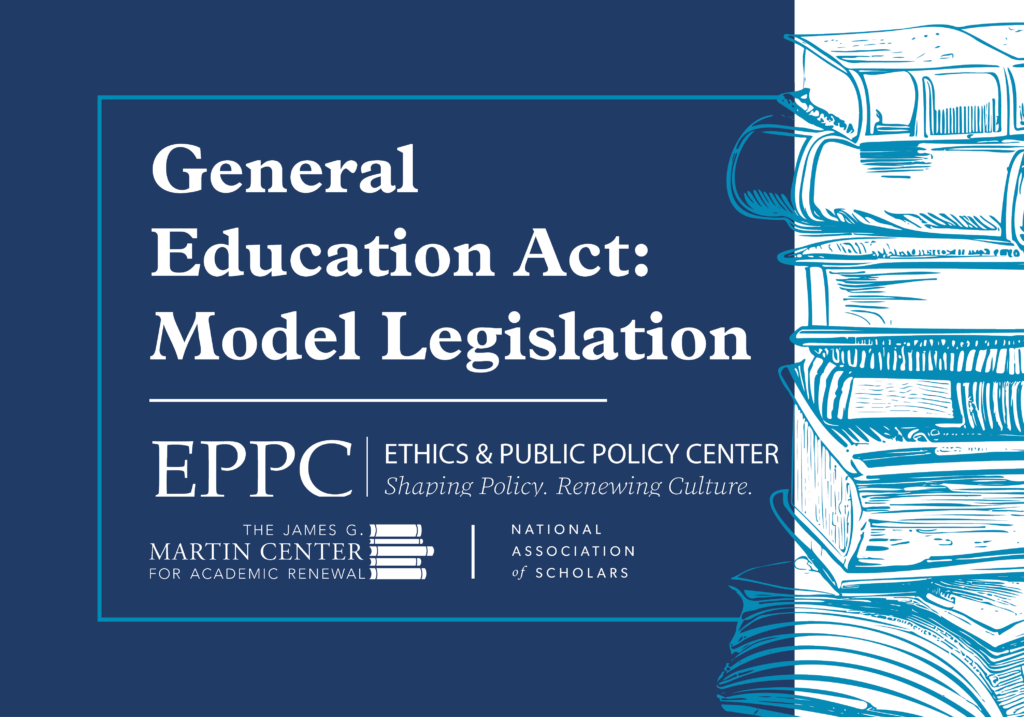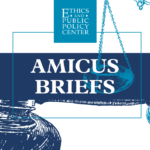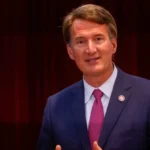
Published November 12, 2023
Introduction
American universities always have recognized citizens’ authority to shape the educational mission of public universities, particularly with respect to “general education”—courses prerequisite to graduation. Appointed or elected university trustees usually represent the citizenry. Trustees set the strategic direction of public universities and create or ratify general education requirements. From time to time, state legislatures do the same. Academic freedom grants professors a large degree of authority over the content of their own individually designed courses. Yet academic freedom does not entitle a professor’s individually designed course to be counted toward the fulfillment of a general-education requirement. The public’s representatives rightly decide that matter.
In the last generation, the American public justly has lost confidence in the higher education establishment’s judgment about general education. They no longer wish to defer to faculty and education administrators who advance their personal politics under the guise of academic expertise. Several state legislatures already have begun to exercise their legitimate authority over the content of general education; the rest should join suit. The failure of public universities to nurture a robust marketplace of ideas, the entrenched conflict between the specialized research interests of faculty and the educational needs of students, and inaction by too many boards of trustees, mean that reform is now impossible without action by legislators in the public interest.
In the past 60 years, American universities abandoned traditional general education requirements that gave students shared knowledge of the history, civilization, and ideals and institutions of America and the West, as well as a proper introduction to science, mathematics, and composition. They substituted distribution requirements, which students could choose to satisfy from a cafeteria menu of courses, with gravely deleterious effects for the students, for the universities, and for America.
The model General Education Act (GEA) proposes a thorough reform of the failed system of cafeteria-style distribution requirements geared to faculty research specialties, rather than to the true requisites of liberal education. GEA first creates a new, independent School of General Education at a selected university, which will assume responsibility for all general education courses, and provides a three-year transition from the old system of general education to the new. GEA then specifies that the general education requirements at a selected state university will consist of a core curriculum of thirteen courses, including Western History, Western Humanities, World Civilizations, United States History, United States Government, and United States Literature, and comprising 42 semester hours. GEA finally states that the university may add no further general education requirements.
GEA restores a common civic education to the center of American public university education—a common civic education that includes examination of fundamental moral and philosophical questions via a study of the history and the greatest books of Western civilization, and the world. America’s public universities enthusiastically supported such common civic education for one hundred fifty years and more, and the creation of a new School and a new core curriculum revives America’s proudest educational tradition. Distribution requirements, at best, have replaced preparation to be a free citizen with pre-professional preparation in the social sciences or the sciences. Public universities’ first duty to the citizens who fund them is to educate their children to assume their role as citizens. So too is public universities’ duty to their students. Universities can provide no greater gift to their students than to teach them about their country and its ideals.
Americans now disagree profoundly about how best to understand the intellectual and historical traditions of America, the West, and the world. Universities must remain free to expose their students to contrasting points of view on these issues. Yet universities only can assign a limited number of general education requirements. They must choose which courses to designate as fundamental components of liberal education and their choice inevitably will register decisions about importance and values. Public universities, which depend upon and serve the citizenries of their states, must and should articulate the state citizenries’ fundamental values. The public, through its representatives, rightly can and should determine general education requirements. A public university’s choice whether to require courses in critical theory or in Western civilization proceeds from underlying value commitments rather than from academic expertise. The public’s representatives therefore have both a right and obligation to make these decisions, as they have done in the past, and as they do now with increasing frequency.
Contemporary administrators’ and professors’ philosophical preference for courses shaped by the faculty’s highly specialized research interests alienates them from the philosophy behind traditional general education. Faculty and administrative resistance therefore frequently has undermined legislators and trustees who direct universities to strengthen traditional liberal education. This unfortunate history makes it necessary to specify the content of required general education courses in a way that clearly states and enforces legislative intent. The model GEA does this by offering clear descriptions of topics to be covered, and by establishing a new School of General Education at a selected public university and by recruiting to that School a faculty with both expertise and interest in the classic general education tradition. The new School of General Education also will have graduate students, and will be able to grant them advanced degrees. This will generate a body of scholars able to staff similar programs in a state university system and in other states.
The creation of a School of General Education designed to revive the tradition of classical liberal education will constitute, for almost any public university that adopts this program, a fundamental shift in educational mission. This broad strategic reorientation will necessitate the discontinuance of some existing academic programs, including some currently existing tenure lines. It is economically unworkable to reconfigure general education substantially, by hiring new faculty with the expertise required to carry out that shift, without shrinking a comparable number of existing programs and faculty. The model GEA provides for this shift. The model also provides for some existing faculty to be granted appointments that would allow them to teach courses under the auspices of the new School of General Education. The key consideration in staffing will be expertise and interest in traditional liberal education.
Traditional liberal education belongs to no single ideology or political party. While too many contemporary academics reject this educational tradition, both liberals and conservatives take inspiration from the tradition of classic liberal education. Traditional general education, after all, dedicates itself to exposing students to the intellectual and historical sources of our pluralist moral, philosophical, and political beliefs, thereby allowing them to develop their own views by learning the best evidence and arguments for all these varying convictions. The charter of the newly established School of General Education highlights the value of intellectual pluralism and welcomes the free, fearless, and civil differences of opinion that naturally exist in any university community.
- GEA achieves its goals in harmony with universities’ vital role to prepare students for careers and to ensure American prosperity.
- GEA’s specified core curriculum only includes 42 semester hours, which is very practicable for a bachelor’s degree. Indeed, public universities that use distribution requirements frequently impose far more onerous general education requirements on students. GEA’s core curriculum will reduce the burden of time and tuition on many students.
- GEA, moreover, recognizes that students pursuing a Bachelor of Science, as opposed to a Bachelor of Arts degree, frequently need an intensive professional preparation, and often have fewer free classes. We have reduced from 13 to 10 the number of required courses for students seeking a BS.
- GEA also allows universities to add up to two courses in a foreign language requirement. Universities should be free to add foreign language preparation to general education requirements—and free to decide that it is not necessary.
We have drafted GEA to be the first step of what should be a broader program of educational reform. It will take some years to establish the School at a selected state university. As that is accomplished, we suggest the following complementary reforms:
- Ensure that all core curriculum courses can be transferred throughout the state public university system.
- Foster dual credit courses in these core curriculum courses by supporting K-12 teacher professional development and other incentives to ensure that high school students can take as many general education courses as possible before going to college.
- Select an accreditor for the selected state university whose mission and experience suits it to accredit a traditional liberal arts core curriculum.
We also have drafted GEA so that it can be modified to suit different states. We use phrases such as {governing board} to allow policymakers to select between university boards, state boards, or other bodies. The entire governance structure of the School of General Studies should be modified to fit local conditions.
Yet we urge policymakers to focus on two aspects of the School.
- The School’s success depends on having both a university president and a Dean of the School of General Education who are truly committed to the traditional ideal of general education, since the president is solely responsible for the appointment of the dean and the dean is solely responsible for establishing the School. Policymakers must ensure that the Board of Trustees (or other responsible authority) rapidly installs a president fully committed to traditional general education, if such a president is not already in place.
- Given the record of administrative and faculty resistance to traditional general education requirements, we have specified that the Board of Trustees shall report regularly to state policymakers about the progress of the School. State policymakers, especially those in specifically tasked committees, also must continue to exercise oversight, to ensure that universities faithfully carry out the legislature’s intention in passing a bill along the lines of this model.
A properly supported School of General Education can remake our public universities into what they once were—the keystones of the American republic.
Stanley Kurtz is a Senior Fellow at the Ethics and Public Policy Center. Beyond his work with Education and American Ideals, Mr. Kurtz is a key contributor to American public debates on a wide range of issues from K–12 and higher education reform, to the challenges of democratization abroad, to urban-suburban policies, to the shaping of the American left’s agenda. Mr. Kurtz has written on these and other issues for various journals, particularly National Review Online (where he is a contributing editor).












